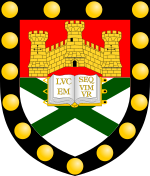The University of Exeter is a research university in the West Country of England, with its main campus in Exeter, Devon. Its predecessor institutions, St Luke's College, Exeter School of Science, Exeter School of Art, and the Camborne School of Mines were established in 1838, 1855, 1863, and 1888 respectively. These institutions later formed the University of Exeter after receiving its royal charter in 1955. In post-nominals, the University of Exeter is abbreviated as Exon. (from the Latin Exoniensis), and is the suffix given to honorary and academic degrees from the university.
The university has four campuses: Streatham and St Luke's (both of which are in Exeter); and Truro and Penryn (both of which are in Cornwall). The university is primarily located in the city of Exeter, where it is the principal higher education institution. Streatham is the largest campus containing many of the university's administrative buildings. The Penryn campus is maintained in conjunction with Falmouth University under the Combined Universities in Cornwall (CUC) initiative. The Exeter Streatham Campus Library holds more than 1.2 million physical library resources, including historical journals and special collections.The annual income of the institution for 2022–23 was £633.5 million of which £118.7 million was from research grants and contracts, with an expenditure of £604.0 million.It was one of the pre-WW2 local university colleges granted university status in the 1950s, as part of the second wave of civic universities. In 2012, Exeter joined the Russell Group of research-intensive UK universities. It is also a member of Universities UK, the European University Association, and the Association of Commonwealth Universities and an accredited institution of the Association of MBAs (AMBA).










